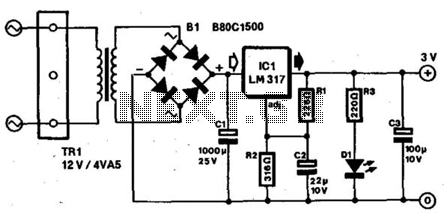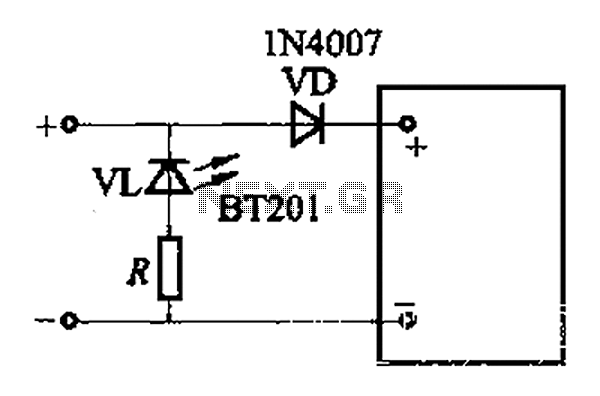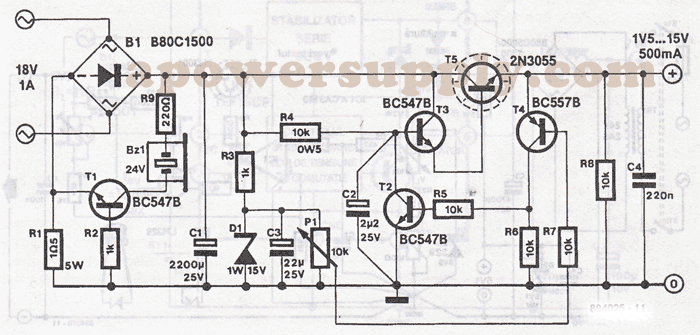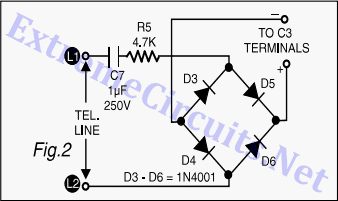
3V Power Supply For Portable Radios

Most small portable radios require a 3-V supply, which is typically provided by two AA or AAA batteries. Many of these radios are equipped with a charger socket since rechargeable batteries are an option. When used in a stationary setting, such as in the kitchen or office, it is convenient and economical to utilize the mains-operated supply described here. This supply is compact enough to be housed inside the radio or within a mains adapter case, making it less bulky than a transformer. The voltage regulator IC1 is configured for an output of 3 V using resistors R1 and R2, which are decoupled by capacitor C2. Capacitor C3 offers additional filtering. Diode D1 indicates whether the unit is connected to the mains and also provides the necessary load for the regulator to function effectively; without this load, the secondary voltage of the transformer could become excessively high when the unit is unloaded. The transformer should be a miniature type that is short-circuit-proof, rated at 12 V and 4.5 VA. The secondary voltage is slightly higher than required for a radio, but this excess is beneficial when the unit is used with a cassette or CD player. It is recommended to verify the output voltage of the unit upon initial power-up before connecting it to a radio or cassette player.
The circuit design for a mains-operated power supply for small portable radios is an efficient solution that integrates seamlessly with the device's existing architecture. The power supply circuit begins with a transformer that steps down the mains voltage to a safer level, in this case, a secondary voltage of 12 V. The transformer must be selected for its short-circuit-proof characteristics to ensure safety and reliability during operation.
Following the transformer, the AC voltage is rectified using a diode bridge configuration, which converts the AC voltage to pulsating DC. The output from this stage is then smoothed using capacitor C2 to reduce ripple voltage, ensuring a stable input for the voltage regulator IC1. The voltage regulator is crucial for providing a consistent output of 3 V, which is necessary for the radio's operation. Resistors R1 and R2 set the output voltage of the regulator, and their values must be selected carefully to ensure accurate voltage regulation.
Capacitor C3 serves as an additional filter capacitor, further smoothing the output voltage and improving the transient response of the power supply. The inclusion of diode D1 not only serves as an indicator for mains connection but also plays a vital role in maintaining the load on the regulator. This load is essential to prevent the secondary voltage from rising excessively when the radio is not in use.
It is important to test the output voltage of the power supply circuit upon initial operation to ensure it meets the required specifications before connecting any sensitive equipment, such as a radio or cassette player. This precaution helps prevent potential damage due to overvoltage conditions. Overall, this power supply circuit is designed to be compact, efficient, and reliable, making it an ideal choice for powering small portable radios in stationary applications. Most small portable radios require a 3-V supply, which is normally provided by two AA or AAA batteries . Because rechargeable batteries are an option with many of these radios, most of them are fitted with a charger socket. When such radios are used in a stationary condition (e.g., in the kitchen or in the office), it is useful (and economical) to use the mains-operated supply described here.
The supply is small enough to be fitted inside the radio or in a mains adapter case (less than transformer). Voltage regulator IC1 is adjusted for an output of 3 V by resistors RI and R2, which are decoupled by C2.
Capacitor C3 provides additional filtering. Diode D1 indicates whether the unit has been connected to the mains. The diode also provides the load necessary for the regulator to function properly; in its absence, the secondary voltage of the transformer might become too high when the unit is not loaded. The transformer should be a short-circuit-proof miniature type, which is rated at 12 V and 4.5 VA. The secondary voltage is slightly higher than needed for a radio, but this reserve is useful when the unit is used with a cassette or CD player.
It is advisable to check the output voltage of the unit when it is switched on for the first time before connecting it to a radio or cassette player. 🔗 External reference
The circuit design for a mains-operated power supply for small portable radios is an efficient solution that integrates seamlessly with the device's existing architecture. The power supply circuit begins with a transformer that steps down the mains voltage to a safer level, in this case, a secondary voltage of 12 V. The transformer must be selected for its short-circuit-proof characteristics to ensure safety and reliability during operation.
Following the transformer, the AC voltage is rectified using a diode bridge configuration, which converts the AC voltage to pulsating DC. The output from this stage is then smoothed using capacitor C2 to reduce ripple voltage, ensuring a stable input for the voltage regulator IC1. The voltage regulator is crucial for providing a consistent output of 3 V, which is necessary for the radio's operation. Resistors R1 and R2 set the output voltage of the regulator, and their values must be selected carefully to ensure accurate voltage regulation.
Capacitor C3 serves as an additional filter capacitor, further smoothing the output voltage and improving the transient response of the power supply. The inclusion of diode D1 not only serves as an indicator for mains connection but also plays a vital role in maintaining the load on the regulator. This load is essential to prevent the secondary voltage from rising excessively when the radio is not in use.
It is important to test the output voltage of the power supply circuit upon initial operation to ensure it meets the required specifications before connecting any sensitive equipment, such as a radio or cassette player. This precaution helps prevent potential damage due to overvoltage conditions. Overall, this power supply circuit is designed to be compact, efficient, and reliable, making it an ideal choice for powering small portable radios in stationary applications. Most small portable radios require a 3-V supply, which is normally provided by two AA or AAA batteries . Because rechargeable batteries are an option with many of these radios, most of them are fitted with a charger socket. When such radios are used in a stationary condition (e.g., in the kitchen or in the office), it is useful (and economical) to use the mains-operated supply described here.
The supply is small enough to be fitted inside the radio or in a mains adapter case (less than transformer). Voltage regulator IC1 is adjusted for an output of 3 V by resistors RI and R2, which are decoupled by C2.
Capacitor C3 provides additional filtering. Diode D1 indicates whether the unit has been connected to the mains. The diode also provides the load necessary for the regulator to function properly; in its absence, the secondary voltage of the transformer might become too high when the unit is not loaded. The transformer should be a short-circuit-proof miniature type, which is rated at 12 V and 4.5 VA. The secondary voltage is slightly higher than needed for a radio, but this reserve is useful when the unit is used with a cassette or CD player.
It is advisable to check the output voltage of the unit when it is switched on for the first time before connecting it to a radio or cassette player. 🔗 External reference





